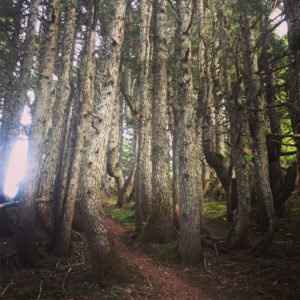We may be a little biased, but we think camping is the BEST way to see Alaska. Fortunately, a lot of other people have that idea, too, which means that there are hundreds of campgrounds all over Alaska, just waiting for you to pull in and set up camp. They range from full-service private RV parks with hookups to little-known tent sites with nothing more than a fire pit—so you can choose just how rugged you want to go. Campgrounds in Alaska are operated by everyone from the National Park Service to the local Parks & Rec division, so navigating all of that information can sometimes get overwhelming. Here are a few resources to help you get started on your camping adventure.
- You don’t have to stay in RV only campgrounds. Our campervans are normal-sized minivans, so you don’t have to choose campgrounds with extra-long RV sites. You can even choose a campground that offers tent camping, even though you won’t need to pitch a tent: You don’t need an RV hookup and don’t need to run a generator, so you won’t run afoul of any noise restrictions.
- Make your reservations in advance when possible. Some of the most popular destinations can fill their spots very quickly, especially in the peak times of the summer. Denali National Park is the size of Massachusetts, but you can still find that their campsites are sold out if you don’t plan ahead. You can book nearly all federally-run campgrounds on the web; search recreation.gov for National Park, National Forest and BLM campgrounds, as well as nearby hiking trails and outdoor activities. All Denali National Park campgrounds can be booked at reservedenali.com.
- Choose campgrounds near activities you would like to experience. Almost all of the state’s campgrounds are located where they are for a reason. Sometimes they’re near popular fishing spots, sometimes near trails, sometimes near lakes and viewpoints. Sometimes they’re simply a halfway point on a long commute. Doing a little research on what is nearby can make your campground stay that much more fun. Alaska State Parks offers a comprehensive list of all state-run campgrounds and RV Parks, along with details on trails and activities in each park.
- Include some campgrounds with showers in your itinerary. There are campgrounds all over the road system with complete bathing facilities. Some of these campgrounds even have laundry services. They’re generally very well maintained and are well worth the extra investment to clean up after a long day hike. The campground page at alaska.org lets you filter the list of campgrounds by amenity, including showers.
- Check for any fire regulations when you arrive. Some parts of Alaska can have dry summers, and even the wet parts can sometimes go through dry spells. This can lead to bans on open flames if there is a high risk of forest fires in the area. Camp stoves usually are NOT included in an open flame ban, so while you may have to forego s’mores for a night, you’ll still be able to eat dinner! Check the campground notice board or with the host for the latest info.
- Remember your water tanks. Your travel van comes equipped with a 9-gallon potable water tank, and a 9-gallon gray (waste) water tank. Most RV parks have a place for you to dispose of your gray water, and some tent campgrounds do, too, as well as some gas stations. We recommend emptying your gray water whenever you have the opportunity. This will increase your fuel efficiency and you won’t be caught unprepared if your next destination doesn’t have a disposal area and your gray water fills up.
Are you inspired yet? We are! Book your travel van now! Or do you have something to add or a question to ask? Let us know in the comments.



Leave A Comment